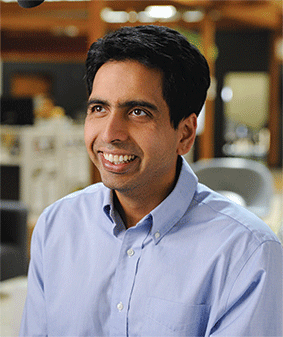India’s youth are hungry for education
 Dilip Thakore interviewed Salman Khan, the US-based founder-CEO of the Khan Academy (KA, estb.2006) over the telephone. Excerpts from the 40-minute late night interview.
Dilip Thakore interviewed Salman Khan, the US-based founder-CEO of the Khan Academy (KA, estb.2006) over the telephone. Excerpts from the 40-minute late night interview.
Since it was launched in 2006, the online Khan Academy (KA) has captured the imagination of the world. How satisfied are you with the growth of KA thus far?
The academy started as a tutorial class for my cousin Nadia and later for family members. After that for almost three years, the possibility of providing free online math and science classes which would be academically enriching and enjoyable for learners anywhere, was something I dreamt about until 2009-10 when my videos uploaded on You-Tube, started getting attention. Since then, the Khan Academy’s website (www.khanacademy.org) has attracted over 31 million learners around the world, a number beyond my wildest dreams. Perhaps more importantly, it has excited people in the US and worldwide and enabled them to dream about accessing high-quality, free-of-charge education at the click of a mouse. I am fairly satisfied with the growth and development of KA thus far. But we have much greater aspirations.
What would you say are the major defining characteristics of the KA way of education delivery that explain its global popularity and success?
I think it’s the disruptive new ideas introduced by KA into the teaching-learning process. Our focus is on de-stressing education and enabling learners to acquire deep understanding of subjects and concepts. This makes learning enjoyable and intellectually satisfying at the basic and advanced levels. Our boldly stated ambitious aspiration to deliver free, good quality education anywhere, anytime has excited people denied of opportunity for whatever reason, to aspire to improve or re-connect with learning.
India with its heterogeneous population and poor internet connectivity is likely to pose an entirely different set of challenges to KA. What are the penetration strategies you have drawn up for KA (India)?
Admittedly, India with its uniquely heterogeneous population, more than 20 major languages and under-developed internet connectivity will pose major problems for the Khan Academy (India). Therefore we are ready and willing to partner with the Central and state governments and NGOs to make content available in Indian languages with the Central Square Foundation having agreed to translate our math and science videos for primary and high schools in India. Re digital connectivity, it must be noted that even in the US, 30 percent of the population, and larger percentages in Brazil and Mexico where our videos and digital reach is deep, don’t have access to broadband connectivity. India is moving rapidly towards developing its digital connectivity and the entire country is likely to be covered in three-five years. We are also open to developing an online-offline model to suit ground conditions in India.
Teachers in the US and elsewhere are not as impressed as is the media with the KA education delivery model. What’s your response?
The perception that KA is a substitute for teachers is a huge misunderstanding. Over 1 million teachers are registered on our website and use our videos and practice sites. The purpose of KA is to be helpful to self-learners and teachers. We wouldn’t have started a physical school — the Khan Academy Lab School — if we didn’t believe in teachers. The point is that great technology enables good teachers to become great teachers.
To what extent is KA in direct competition with commerce-driven online education and tutorial companies?
We are in competition with them and as broadband connectivity becomes available to a greater number of people, life will become difficult for them as our aspiration is to provide high quality learning programmes to people anywhere free-of-charge.
Nor is it true that our learning programmes are designed only for learners from low-income households or school dropouts and self-learners. Our aspiration is that the learning programmes of KA should be perceived as the gold standard of education, and the fact that children from wealthy families including the children of Bill and Melinda Gates are registered users on the KA online academy, is proof that our learning programmes are as good as any.
Unlike the US where education is high on the government radar, in India public K-12 education is a low priority of governments. In the circumstances how optimistic are you about the prospects of KA (India)?
I am very optimistic. During my recent visits to India, I found that prime minister Modi and state government leaders are serious about upgrading India’s public education system. Admittedly, given the country’s uniquely heterogeneous population and languages and connectivity problems, KA (India) won’t be an overnight success. But with broadband connectivity and smart phones technology improving very rapidly, online and offline content will become more accessible to the majority of the population. India has the world’s largest youth population with hunger for education. I am optimistic that if it’s given access to high quality content anywhere, anytime, the country will experience a learning revolution.















Add comment